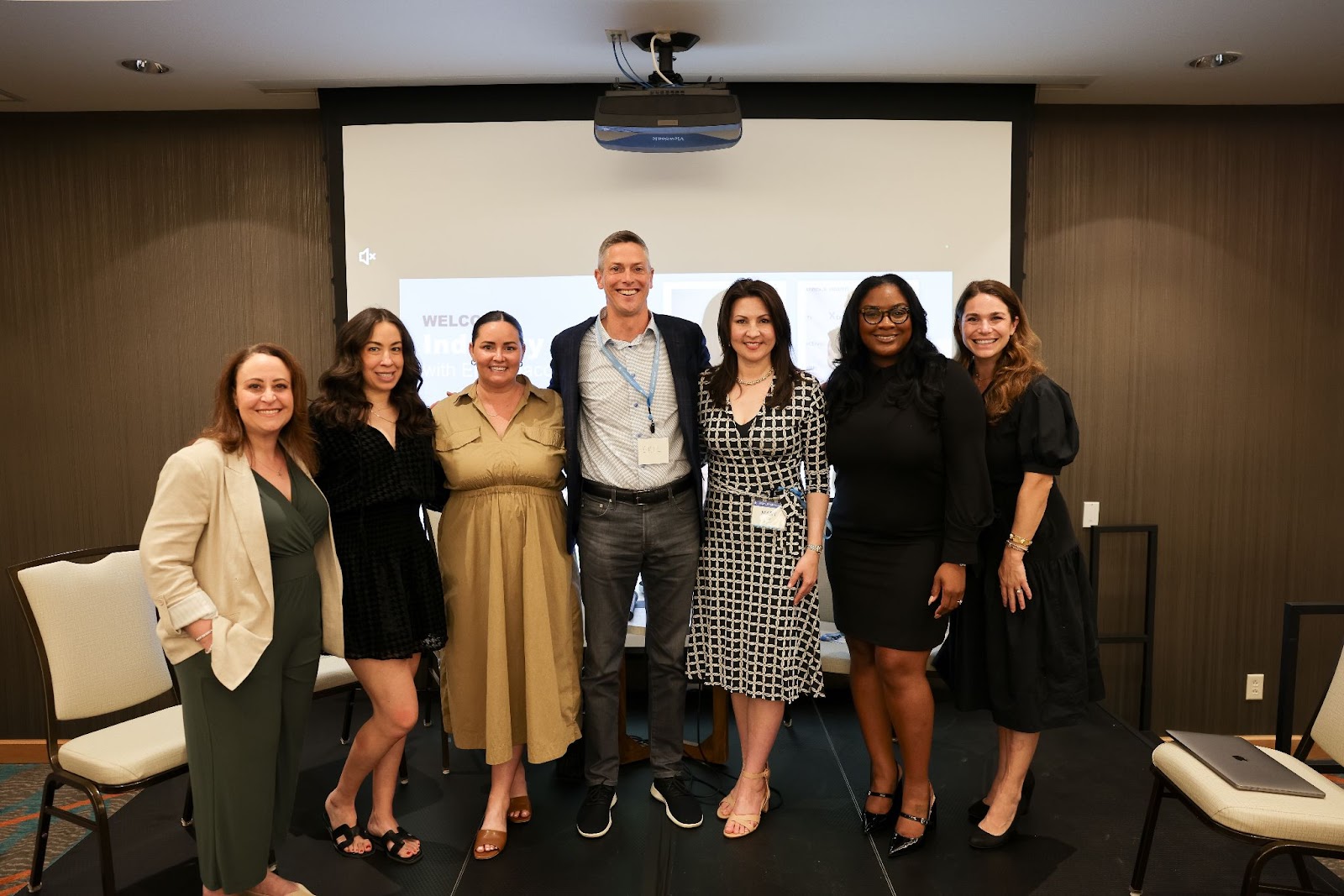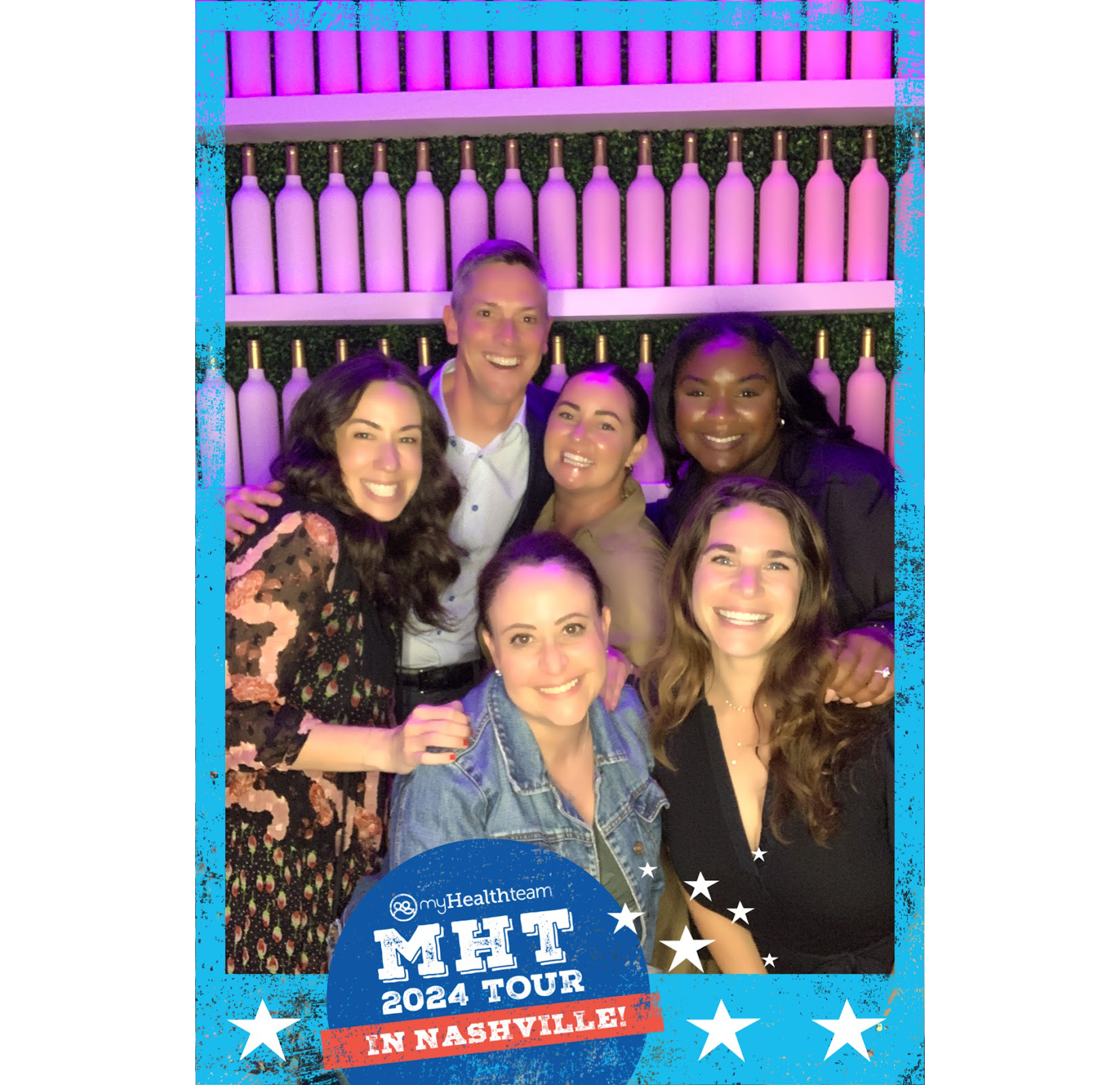The New Marketing Playbook: Engaging Patients in the Era of AI, Personalization, Patient Privacy, and Direct-to-Patient Offerings
By Eric Peacock, Co-founder and CEO, MyHealthTeam
At MyHealthTeam’s all-company get-together in Nashville, we invited five pharma marketing experts from top agencies and biotechs to join me on a panel. We discussed the “New Marketing Playbook” for everything from rare disease launches to direct-to-patient models to innovative uses of AI with patients.
Our amazing panelists included:
- April Clayton, bluebird bio
- Kait Holden, HealixGlobal
- Italia Mombello, Greater Than One
- Alison Tapia, Dermavant Sciences
- Jessica Zoldessy, HealixGlobal

Pictured from left to right are Alison Tapia of Dermavant Sciences, Jessica Zoldessy and Kait Holden of HealixGlobal, MyHealthTeam co-founders Eric Peacock and Mary Ray, April Clayton of bluebird bio, and Italia Mombello of Greater Than One.
Our panelists expressed their own views, which do not necessarily reflect the positions of their employers.
Here are some highlights from our discussion:
1. Rare Disease Launches Require Time, Trust, and Co-Creation With the Community
“There should be no decisions made about the sickle cell disease community without the sickle cell disease community,” explained April Clayton, associate director of sickle cell disease digital and engagement marketing at bluebird bio. That was the mantra adopted by bluebird bio as they launched a groundbreaking gene therapy for sickle cell disease, a genetic condition that disproportionately impacts people of African American and West African descent. She explained her team had a sense of partnership with Sickle Cell Warriors to ensure “It was about the community first, and product second.”
It can take years of groundwork, partnering with patient communities, attending condition-specific conferences for rare diseases, and co-creating messaging and education materials to build trust among rare disease communities.
Takeaways:
- Engage the patient community early and in all stages. Give them a seat at the table where decisions are being made.
- Be transparent and committed. Some rare disease communities have seen pharmaceutical companies come and go with their support.
- Co-create. Involve the patient community in decisions about the patient community.
2. Direct-to-Patient Health Care Models Are Coming
Pharma is moving toward direct-to-patient (also called direct-to-consumer or DTC) health care models. Companies like Eli Lilly (with LillyDirect) and AstraZeneca are expanding access to therapies through telehealth and direct-to-patient channels. This shortens the time it takes patients to get care and potentially expands access to underserved populations who find it difficult to miss work for a doctor’s appointment. It presents a huge opportunity to improve outcomes and expand the traditional pharma marketing playbook, but hurdles remain. “The DTC model’s success hinges on overcoming logistical hurdles and ensuring regulatory compliance,” explained Jessica Zoldessy, director of digital partnerships at HealixGlobal.
As a vitiligo patient who recently used telehealth myself, I can attest to this. I’m happy to report that I was able to get a diagnosis and prescription via telehealth in a day, but it took three attempts with different pharmacies and a 45-minute phone call with my insurance company before I was able to finally get the drug covered by insurance and shipped to my house. Still, it was a lot faster than the four-month waiting time to get an appointment with my dermatologist in California.
Not all diseases lend themselves to telehealth diagnosis and treatment, but initial telehealth consultations can be the catalyst to get patients further down the road to seeing a specialist in person. One big application could be in helping patients get screened for rare conditions.
“The potential of direct-to-patient genetic screening is a revolutionary approach for rare diseases, bypassing traditional health care barriers for those who don’t have access,” shared Italia Mombello, director of media strategy at Greater Than One. If we can engage patients while they are learning about a potential disease and get them on the path for diagnostic or screening tests, it can vastly improve the efficiency of their first in-person visit and shorten time to diagnosis.
Takeaways:
- Direct-to-patient models aren’t just for hair loss, acne, obesity, and migraine anymore. Expect to see these options coming into specialty pharmacy.
- Even if a disease ultimately requires an in-person visit, an initial telehealth visit can be the catalyst to scheduling that appointment or getting diagnostic or genetic screening tests underway.
- This could represent a significant opportunity in the dermatology market, where it is hard to get an appointment — let alone find experts in complex conditions like vitiligo, hidradenitis suppurativa, psoriasis, seborrheic dermatitis, and more.
3. Be Where the Patients Are, in the Formats They Consume
Panelists emphasized being agile in adopting new technologies and formats to understand patient needs and reach them with your messaging. “Leveraging new patient channels like social media and short-form video is a smart and successful approach in reaching patients,” shared Alison Tapia, senior director of performance marketing and digital innovation at Dermavant Sciences. Of course, that means having to do the work with your legal and regulatory groups to help them understand the shorter formats and story arcs of Reels, for example. The risk of not sharing your medically valid information in new social formats, Alison added, is that your message doesn’t get heard. Or worse — patients receive misinformation from other sources that post there.
Jessica, who spends a lot of time on rare disease launches at Healix, added, “We have patient communities on all of our media plans for rare diseases.”
“Be a part of the community in a way that doesn’t feel too transactional,” said Kait Holden, group media director and VP at HealixGlobal. It is vital to understand challenges, leverage patient insights, and maintain flexibility throughout your marketing efforts, from pre-launch to go-to-market strategies. In some instances, Kait pointed out, the job is to help educate patients with rare diseases about the signs and symptoms their normal health care providers might miss due to lack of training on that condition.
Takeaways:
- Be on social media and adopt new formats to reach patients where they are, in the format they want to digest.
- Make sure you listen to the patient sentiment and dialogues in these channels to identify the hurdles, frustrations, and education gaps. Use that to inform your presence and voice.
4. Incorporate AI Into the Patient Marketing Playbook
All the panelists agreed that AI will have a significant impact on direct-to-patient marketing. They pointed to its current use in building predictive models to identify patients and health care providers for more targeted, privacy-compliant marketing outreach. Some of the panelists’ companies, as well as MyHealthTeam, are using AI to offer patients self-assessment tools. These tools can motivate someone to get an official diagnosis from a physician, help answer questions using information from a vetted set of medically approved sources, or even help people find and connect with other patients going through the same symptoms or treatments.
I shared the results of an initial test MyHealthTeam ran on myRAteam, using an AI chatbot to answer open-ended questions for patients with rheumatoid arthritis. Our bot sourced information from our library of articles, which have been medically approved by RA specialists to ensure accuracy. What we found surprised us. Patients were surprisingly short when it came to asking open-ended questions about their condition. However, 83 percent of users clicked links to sample questions that were tailored to them based on their needs.
In other words, patients don’t always know what to ask. When you invite them into a conversation that is relevant to them, they are happy to answer more questions and provide more information that will lead to a more personalized answer.
Takeaways:
- Use AI to invite patients into the conversation, and give them questions to which they can respond. Don’t expect them to start the chat.
- Use AI to help patients get to diagnosis much faster and act as a catalyst for seeing a specialist.
- Make the AI seamless. AI is not the product. Solving the patient’s problem or delivering personalized information to them is the product.
- ChatGPT functionality will become one of the most natural ways to collect zero-party data that enables you to personalize your messaging to patients.
- AI tools will streamline workflow, help predict patient-engagement scenarios, and create more personalized online search prompts to aid in doctor discussions.
What I love about these five panelists (besides what a fun group they are to hang out with) is how much each of them embraces new technologies to reach patients when and where they want to learn about treating their diseases.

Let’s continue to collaborate, share insights, and drive meaningful change for patients. If you want to learn more about bringing this playbook to patients, check out Top 10 Quotes From the PHM Healthfront Stage and Top 5 Themes From Reuters Pharma USA: A Glimpse Into the Future of Pharma Marketing.

